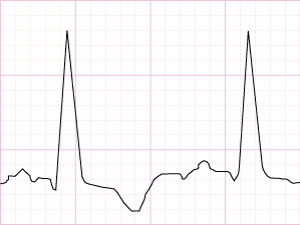Cardiology Teaching Package
A Beginners Guide to Normal Heart Function, Sinus Rhythm & Common Cardiac Arrhythmias
Supra-Ventricular Tachycardia Rythms
Image: Sinus Tachycardia (close up)

Although the rate is 140 bpm, it is possible to clearly identify the P wave, QRS complex and T wave.
Image: Sinus Tachycardia (full strip)

Supra-Ventricular Tachycardia
Image: Supra-Ventricular Tachycardia Rythms (close up)

Image: Supra-Ventricular Tachycardia Rythms (full strip)

The rhythm above is too fast to diagnose. All we can tell is that the ventricles are depolarising normally, as indicated by the narrow QRS complex.
This rhythm needs slowing down in order to diagnose and decide on treatment. Adenosine and Digoxin are the two drugs used for slowing down the heart.
Once the rhythm is slowed down to below 140 bpm it is usually possible to identify it. It may then look like one of the categories discussed above and then further treatment can be decided upon.
